Bichop R.H. (Ed.) Mechatronic Systems, Sensors, and Actuators: Fundamentals and Modeling
Подождите немного. Документ загружается.


20-64 Mechatronic Systems, Sensors, and Actuators
The following sections will consider the most popular types of flowmeter from each of the eight main
categories in Table 20.3. For information on other flowmeters and those in the miscellaneous group see
one of the many textbooks on flow measurement such as [3–6].
20.5.5 Differential Pressure Flowmeter
The basic principle of nearly all differential pressure flowmeters is that if a restriction is placed in a pipeline,
then the pressure drop across this restriction is related to the volumetric flowrate of fluid flowing through
the pipe.
The orifice plate is the simplest and cheapest type of differential pressure flowmeter. It is simply a
plate with a hole of specified size and position cut in it, which can then be clamped between flanges in
a pipeline (Figure 20.53). The volumetric flowrate of fluid Q in the pipeline is given by:
(20.66)
where p
1
and p
2
are the pressures on each side of the orifice plate,
ρ
is the density of the fluid upstream
of the orifice plate, d is the diameter of the hole in the orifice plate, and
β
is the diameter ratio d/D
where D is the upstream internal pipe diameter. The two empirically determined correction factors are
C the discharge coefficient, and
ε
the expansibility factor. C is affected by changes in the diameter ratio,
Reynolds number, pipe roughness, the sharpness of the leading edge of the orifice, and the points at
which the differential pressure across the plate are measured. However, for a fixed geometry it has been
shown that C is only dependent on the Reynolds number and so this coefficient can be determined for
a particular application.
ε
is used to account for the compressibility of the fluid being monitored. Both
C and
ε
can be determined from equations and tables in a number of internationally recognized
TABLE 20.3 Main Categories of Closed Conduit Flowmeter
Type 1—differential pressure flowmeters
Sharp edged orifice plate, chord orifice plate, eccentric orifice plate, Venturi,
nozzle, Pitot tube, elbow, wedge, V-cone, Dall tube, Elliot–Nathan flow tube,
Epiflo
Type 2—v ar iabl e area flowmeters
Rotameter, orifice and tapered plug, cylinder and piston, target, variable
aperture
Type 3—positive displacement flowmeters
Sliding vane, tri-rotor, bi-rotor, piston, oval gear, nutating-disc, roots, CVM,
diaphragm, wet gas
Type 4—t urbine flowme ters
Axial turbine, dual-rotor axial turbine, cylindrical rotor, impeller, Pelton
wheel, Hoverflo, propeller
Type 5—o scillatory fl ow meters
Vortex shedding, swirlmeter, fluidic
Type 6—electromagnetic flowmeters
AC magnetic, pulsed DC magnetic, insertion
Type 7—ultrasonic flowmeters
Doppler, single path transit-time, multi-path transit-time, cross-correlation,
drift
Type 8—mass flowmeters
Coriolis, thermal
Type 9—miscellaneous flowmeters
Laser anemometer, hot-wire anemometers, tracer dilution, nuclear magnetic
resonance
Q
C
1
β
4
–
-------------------
ε
π
4
---
d
2
2 p
1
p
2
–()
ρ
-----------------------=
9258_C020_Sec_4-6.fm Page 64 Tuesday, October 9, 2007 9:09 PM
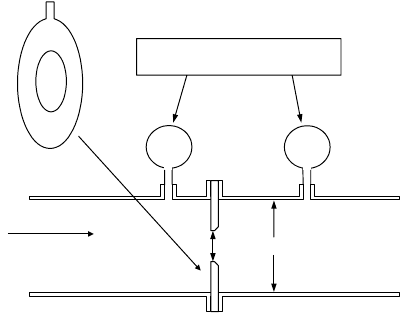
Sensors 20-65
documents known as standards. These standards not only specify C and
ε
, but also the geometry and
installation conditions for the square-edged orifice plate, and two other common types of differential
pressure flowmeters, the Venturi tube and nozzle. Installation recommendations are intended to ensure
that fully developed turbulent flow conditions exist within the measurement section of the flowmeter.
The most commonly used standard in Europe is ISO 5167-1 [7], while in the USA, API 2530 is the
most popular [8]. Thus, one of the major reasons for the continued use of the orifice plate flowmeter
is that measurement uncertainty (typically ±2% of reading) can be predicted without the need for
calibration, as long as it is manufactured and installed in accordance with one of these international
standards.
The major disadvantages of the orifice plate are its limited range and sensitivity to changes in the
flow’s velocity profile. The fact that fluid flow rate is proportional to the square root of the measured
differential pressure limits the range of a one plate/one differential pressure transmitter combination to
about 3:1. The required diameter ratio (also known as beta ratio) of the plate depends on the maximum
flow rate to be measured and the range of the differential pressure transducer available.
Equation 20.66 assumes a fully developed and stable flow velocity profile, and so installation of the
device is critical, particularly the need for sufficient straight pipework, upstream and downstream of the
meter. Wear of the leading edge of the orifice plate can also severely alter measurement accuracy and so
this device is normally only used with clean fluids.
The other two differential pressure flowmeters covered by international standards are the Venturi tube
and nozzle. The Venturi tube has a lower permanent pressure less than the orifice plate, and is less
sensitive to erosion and upstream disturbances. Major disadvantages are its size and cost. It is more
difficult, and therefore more expensive, to manufacture than the orifice plate.
Nozzles have pressure losses similar to orifice plates but because of their smooth design they retain
their calibration over a long period. However, these devices are more expensive to manufacture than the
orifice plate but cheaper than the Venturi tube. The two most common nozzle designs of nozzle are
covered by international Standards, with the ISA-1932 nozzle being preferred in Europe and the ASME
long radius nozzle being preferred in the U.S.
There are many other types of differential pressure flowmeter, such as the segmental wedge, V-cone,
elbow, and Dall tube. Each of these has advantages over the orifice plate, Venturi tube, and nozzle for
specific applications. For example, the segmental wedge can be used with flows having a low Reynolds
number, and a Dall tube has a lower permanent pressure loss than a Venturi tube. However, none of
these instruments are yet covered by international standards and so calibration is needed to determine
their accuracy.
FIGURE 20.53 Flowrate measurement using an orifice plate.
Orifice plate
Flow direction
Pressure drop across flowmeter
is a measure of fluid flowrate
p
1
p
2
d D
9258_C020_Sec_4-6.fm Page 65 Tuesday, October 9, 2007 9:09 PM
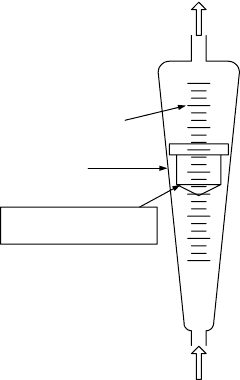
20-66 Mechatronic Systems, Sensors, and Actuators
20.5.6 Variable Area Flowmeter
Variable area flowmeters are also based on using an obstruction in the flow to create a differential pressure
principle, except in this case the differential pressure is constant and the area of the obstruction varies
as the flowrate being measured changes. Probably the best known type of variable area flowmeter is the
taper tube and float flowmeter, known almost universally as a rotameter (Figure 20.54). This type of
flowmeter consists of a vertical tapered tube into which a float or bob is fitted. The fluid being metered
enters the tube at the bottom and forces the float up the tube, which also increases the cross-sectional
area available around the float for the fluid to pass through. Increasing the flowrate will move the float
further up the tube, and so the position at which the float comes to rest is a direct function of flowrate.
Rotameters are extremely simple and reliable, and have an output which changes linearly with flowrate
(unlike differential pressure flowmeters) and a typical range of 10:1 (compared to 3:1 for differential
pressure flowmeters). Accuracy is typically ±2% of full scale, but will depend on range and cost of the
device. In addition, the flowmeter’s calibration is insensitive to changes in the velocity profile of the flow.
Since the tube can be made of glass or clear plastic, a visual indication of flowrate is directly available
and, of course, the flowmeter requires no external power supply in order to function. As a result such
flowmeters are commonly found in many process and laboratory applications where gases or liquids
need to be metered. If high temperature, high pressure, or corrosive fluids need to be metered, the
rotameter’s tube can be made of metal. In such cases a mechanism for detecting and displaying the
position of the float is required.
A major limitation of the rotameter is that it can usually only be used vertically and so causes
installation difficulties if the pipeline being metered is horizontal. Some manufacturers produce spring
loaded rotameters, which can be used in any position; however, in general these have poorer accuracy
than standard rotameters. Other limitations are that the calibration of the meter is dependent on the
viscosity and density of the fluid being metered, and producing an electrical output signal suitable for
transmission requires extra complexity. However, the use of optical or magnetic limit switches to enable
the flowmeter to be used in high or low flow alarm applications is common.
20.5.7 Positive Displacement Flowmeter
Positive displacement flowmeters are based on a simple measurement principle. The flow being measured
is “displaced” or moved from the inlet side of the flowmeter to the outlet side using a series of compart-
ments of known volume. The number of compartments of fluid that have been transferred are counted
to determine the total volume that has passed through the flowmeter, and if time is also measured then
FIGURE 20.54 Tapered tube and float variable area
flowmeter.
Float position is a measure
of fluid flowrate
Calibrated
scale
Flow direction
Tapered tube
9258_C020_Sec_4-6.fm Page 66 Tuesday, October 9, 2007 9:09 PM
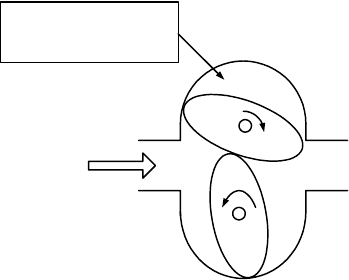
Sensors 20-67
volumetric flowrate can be measured. There are many designs of positive displacement flowmeters
commercially available. For liquids the most common designs are piston, sliding vane, oval-gear, bi-rotor,
tri-rotor, and disc types of flowmeter while for gases roots, bellows (or diaphragm), or CVM flowmeters
are popular. Despite this wide range of design all are based on the same principle and all are predominantly
mechanical devices.
The advantages of positive displacement flowmeters are that they are capable of high accuracy mea-
surement (typically ±0.5% of reading for liquids and ±1% of reading for gases) over a wide range of
flowrates. They can be used to meter fluids with a wide range of viscosity and density. In addition, unlike
most other flowmeters, they are insensitive to changes in flow velocity profile and so do not require long
lengths of straight pipe work before and after the flowmeter.
Figure 20.55 shows the principle of the oval-gear flowmeter and illustrates the limitations of positive
displacement flowmeters. They are relatively complex mechanical devices, with moving parts which of
course wear with time. Their measurement accuracy depends both on the initial quality of manufacture
and a regular maintenance schedule once in use. Fluids being metered should also be free of solid particles
so as to reduce wear of the seals and reduce the need for excessive maintenance. Positive displacement
flowmeters can also be heavy and expensive for larger pipe sizes and some designs can result in a complete
blockage of the pipeline if the flowmeter seizes up.
20.5.8 Turbine Flowmeter
Like the positive displacement flowmeter, turbine (or vane) flowmeters are mechanical devices capable of
achieving high measurement accuracy. The principle of operation of this type of flowmeter is that a multi-
bladed rotor is placed in the flow and rotates as fluid passes through it. The rotor’s speed of rotation is
detected using a sensor (rf, magnetic, and mechanical types being the most common), and is proportional
to the velocity of the fluid flowing through the meter. These flowmeters measure the average velocity of
fluid in a pipeline, and since the pipe diameter is known, volumetric flowrate can be determined.
Despite the fact that the turbine flowmeter is a mechanical device which may appear to be old fashioned
when compared to many other technologies available, it is still one of the most accurate and repeatable
flowmeters available today. Measurement accuracy of better than ±0.1% of reading for liquids, and better
than ±0.25% of reading for gases, is possible using this type of flowmeter. For this reason the turbine
flowmeter is one of the most commonly used instruments in custody transfer applications. These flow-
meters have a linear output and a range of at least 10:1, with 100:1 possible in some applications.
The main limitation of the turbine flowmeter is the fact that key mechanical components such as the
rotor bearings will wear with use, and in doing so degrade the instrument’s repeatability and alter its
calibration. Regular maintenance and recalibration are therefore necessary with this type of flowmeter.
Care should also be taken to ensure that the fluid being metered is clean, since solid particles in the flow
FIGURE 20.55 The oval-gear positive displacement flowmeter.
Fixed volume of fluid
moved from inlet to outlet
by gear rotation
Flow
direction
9258_C020_Sec_4-6.fm Page 67 Tuesday, October 9, 2007 9:09 PM
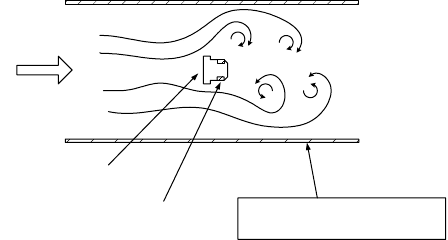
20-68 Mechatronic Systems, Sensors, and Actuators
will cause more rapid bearing wear. The flowmeter’s calibration is also sensitive to changes in fluid
viscosity and upstream flow velocity profile.
Other types of flowmeters which use the turbine principle include the Pelton wheel and propeller
meter, although they have poorer measurement accuracy than axial designs.
20.5.9 Vortex Shedding Flowmeter
The vortex shedding flowmeter, now more commonly known as the vortex flowmeter, relies on the
phenomena of vortex shedding, which was first experimentally studied by Strouhal in 1878. Figure 20.56
shows the principle of the vortex flowmeter. A nonstreamlined obstruction known as a shedder bar or
bluff body is placed across the middle of the flow stream. As the fluid stream in the pipe hits this obstacle
it must separate to pass around it, with fluid layers nearer the surface of the bar moving slower than
those further away. As a result, when these fluid layers recombine after passing the bar, vortices are
generated and shed alternately from either side of the shedder bar. The frequency of generated vortices
is related to the upstream velocity of the fluid and the width of the shedder bar and is defined by the K
factor of the flowmeter. For a given geometry of shedder bar the K factor of a flowmeter is relatively
constant over a wide range of pipe Reynolds number, and so in these circumstances the volumetric
flowrate of the fluid is linearly related to the vortex shedding frequency.
The frequency of generated vortices is usually detected using sensors integrated into the sides of the
shedder bar. Pressure, capacitance, thermal, and ultrasonic are the most common types of sensor used
for this purpose.
The vortex flowmeter is capable of accurate measurement of liquid or gas (typically ±1% of reading)
over a minimum flow range of 30:1. The flowmeter can also be used over a wide range of fluid temperatures
and so is commonly used for metering process fluids at the extreme ends of the temperature range, such
as liquid nitrogen and steam. The instrument’s calibration is also insensitive to changes in fluid density,
and so a meter’s calibration holds for any fluid as long as the flowmeter is used within the Reynolds
number range specified by the manufacturer. The vortex flowmeter has a simple and reliable construction
and so can be used with flows containing small amounts of particles, although more extreme multiphase
flows such as slurries will cause rapid wear of the shedder bar and so a change in calibration. The relatively
small obstruction that the shedder bar causes results in a permanent pressure loss of about half that of an
orifice plate over the same range of flowrate.
The main limitation of the vortex flowmeter is that it can only be used in turbulent flow conditions.
It is, therefore, not usually suitable for use in large pipe diameters, or in applications where the flow
velocity is low or the fluid viscosity high. Most manufacturers set a minimum Reynolds number of
typically 10,000 at which the specified flowmeter performance can be achieved. While many flowmeters
will continue operating at Reynolds numbers less than this, the generated vortex stream becomes less
stable and so accuracy is reduced. At a Reynolds of less than around 3000, vortices will not be generated
FIGURE 20.56 Principle of the vortex shedding flowmeter.
Flow direction
Shedder bar
Vortex detector
Frequency of generated vortices
is a measure of fluid velocity
9258_C020_Sec_4-6.fm Page 68 Tuesday, October 9, 2007 9:09 PM
Sensors 20-69
at all and so the flowmeter will stop operating. The vortex flowmeter is also sensitive to changes in
upstream flow velocity profile and other disturbances such as swirl, and so should be installed with a
sufficient straight length of pipe upstream and downstream of the measurement point. The flowmeter
should not be used in applications where pipe vibration or local sources of electrical interference are
high, since this will corrupt the vortex signal being detected and possibly give false readings under no-
flow conditions.
20.5.10 Electromagnetic Flowmeter
The operation of the electromagnetic flowmeter is based on Faraday’s law of induction, that is, when a
conductor is moving perpendicular to a magnetic field, the voltage induced across the conduction is
proportional its velocity. In the case of the electromagnetic flowmeter, the conductor is the fluid being
metered, while the induced voltage is measured using electrodes in the pipe wall. Since in most applica-
tions the pipe wall of the flowmeter is made from a conductive material such as a stainless steel, an inner
nonconducting liner is required to insulate the electrodes and prevent the generated voltage signal being
dissipated into the pipe wall. Coils on the outside of the pipe are used to generate a magnetic field across
the fluid, with simpler AC coil excitation methods which suffer from zero drift problems being increas-
ingly replaced by pulsed DC excitation techniques which do not.
The electromagnetic flowmeter has a number of advantages over traditional flow measurement tech-
niques, and some characteristics of an ideal flowmeter. The flowmeter has no moving parts, does not
obstruct the pipe at all, is available in a very wide range of pipe sizes, and may be used to measure
bidirectional flows. A measurement accuracy of typically ±0.5% of reading over a range of at least 10:1
is possible. The flowmeter’s accuracy is also unaffected by changes in fluid viscosity and density, and may
be used to meter difficult mixtures such as slurries and paper pulp.
The major limitation of the electromagnetic flowmeter is that it can only be used with fluids with a
conductivity of typically greater than 5 µS/cm, although special designs are available for use with liquids
with conductivities of as low as 0.1 µS/cm. The flowmeter is, therefore, not suitable for use with gases,
steam, or nonconducting liquids such as oil. The flowmeter’s calibration is also sensitive to changes in
flow velocity profile although requiring a shorter straight length of pipe upstream of the meter than the
orifice plate or turbine meter. Although electromagnetic flowmeters do not require significant mainte-
nance, care must be taken during operation to ensure that the liner does not become damaged, and that
significant deposits do not build-up on the electrodes, since these can cause changes in the calibration
or in some cases cause the flowmeter to stop functioning altogether. Even if these effects are minimized,
electromagnetic flowmeters will require periodic recalibration using either traditional techniques or an
electronic calibrator now available as an accessory from most manufacturers.
20.5.11 Ultrasonic Flowmeter
The dream of producing a universal non-invasive flowmeter has been the catalyst for the many different
ultrasonic flowmeter configurations, which have been investigated over the last 40 years [9]. However,
most ultrasonic flowmeters commercially available today can be placed into one of two categories—
Doppler and transit-time.
The ultrasonic Doppler flowmeter is based on the Doppler shift principle. Ultrasound at a frequency of
typically 1 MHz is transmitted at an angle into the moving fluid being monitored. Some of this energy will
be reflected back by acoustic discontinuities such as particles, bubbles, or turbulent eddies. The difference
in frequency between the transmitted and received signals (the Doppler frequency shift) is directly propor-
tional to the velocity of the flow.
The ultrasonic transducers, which are used to transmit and receive the ultrasound, are usually located
in a single housing that can be fixed onto the outside of the pipe, and so a simple clamp-on flowmeter,
which is easy to install and completely noninvasive, is possible.
9258_C020_Sec_4-6.fm Page 69 Tuesday, October 9, 2007 9:09 PM
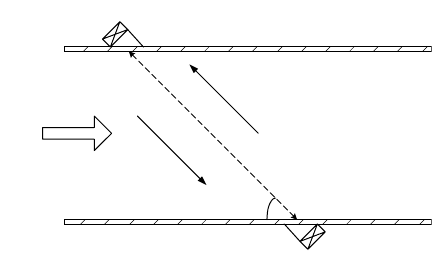
20-70 Mechatronic Systems, Sensors, and Actuators
The reflected ultrasound does not consist of a single frequency, but a spread of frequencies resulting
from reflections from a range of different sized discontinuities, which may also be travelling at different
velocities travelling through the detection area. For liquids the frequency of the transmitted ultrasound
may lie in the range from 500 kHz up to a few megahertz. At 500 kHz discontinuities must have a diameter
of approximately 50
µ
m in order to reflect ultrasound back to the receiver. Increase in the operating
frequency will allow the detection of smaller particles, but at the cost of reducing the penetration of the
transmitted signal into the fluid. The flowmeter is also sensitive to changes in flow velocity profile and
the spatial distribution of discontinuities in the flow. As a result the accuracy of Doppler flowmeters is
poor, typically ±5% of full scale. However, this can be improved by calibrating the flowmeter on-line.
Since there is a large acoustic mismatch between steel and air, clamp-on Doppler flowmeters cannot be
used for metering gas flows or, of course, totally clean liquids where there are insufficient reflecting particles
or bubbles to produce a reliable Doppler signal.
Figure 20.57 illustrates the basic principle of the ultrasonic transit-time flowmeter. Two ultrasonic
transducers are mounted on either side of the pipe, so that ultrasound can be transmitted across the
fluid flowing in the pipe. The difference in the time it takes for a pulse of ultrasound to travel between
transducer 1 and 2 (with the flow) and transducer 2 and 1 (against the flow) is given by
(20.68)
Since the velocity of sound in the fluid c is much greater than the velocity of the fluid v, then
(20.69)
Therefore, if the velocity of sound in the fluid is constant, then there is a linear relationship between ∆T
and v.
Although this method is elegant and straightforward in principle, in practice there are difficulties since
∆T can be small, and the change in ∆T that occurs with changing fluid velocity is even smaller (typically
fractions of microsecond per meter). In addition, as Equation 20.68 shows, if the temperature of the
fluid changes then c will change. Measurement of, and correction for, changes in the fluid temperature
are usually needed. Transit-time flowmeters, therefore, require the measurement complex signal condi-
tioning and processing.
FIGURE 20.57 Principle of the transit-time ultrasonic flowmeter.
Flow velocity v
θ
Ultrasonic
transducer 1
Ultrasonic
transducer 2
l
∆T
2lv
θ
cos
c
2
v
2
cos
2
θ
–
----------------------------
=
∆T
2lv
θ
cos
c
2
---------------------
≈
9258_C020_Sec_4-6.fm Page 70 Tuesday, October 9, 2007 9:09 PM
Sensors 20-71
The flow velocity v, which is calculated using Equation 20.68, is the average velocity along the trans-
mission path between the two transducers, and so the flowmeter’s calibration will be very dependent on
the flow velocity profile. The problem of flow regime dependency can be significantly reduced by using
a configuration of several parallel ultrasonic beams and averaging the measured mean velocity along each
beam to calculate the overall fluid velocity. This is analogous to numerical integration, and a wide range
of multibeam configurations have been proposed, each with their own advantages.
Single path ultrasonic transit-time flowmeters have a typical accuracy of ±2% of reading over a range
of at least 100:1. Although this type of flowmeter can be used with liquids or gases, clamp-on designs
can only be used with liquids. Multibeam flowmeters have an improved accuracy, but are more expensive.
However, they are finding increased use in high value applications like the custody transfer of natural
gas. Unlike most other flowmeters, the cost of transit-time flowmeters does not increase significantly
with pipe diameter. Transit-time flowmeters are intended for use with clean fluids, although most can
still operate if there are a small amount of impurities present in the flow.
20.5.12 Coriolis Flowmeter
The Coriolis flowmeter can be used to measure the mass flowrate of a fluid directly. As the name suggests,
the principle of operation makes use of the Coriolis effect discovered by Gustave Coriolis in 1835. The
fluid being metered passes through a vibrating tube, and as a result of the Coriolis force acting on it, the
fluid will accelerate as it moves towards the point of maximum vibration and decelerate as it moves away.
This will result in flexure of the tube, the amount of flexure being directly proportional to the mass
flowrate of the fluid.
The first commercial Coriolis flowmeter used a U-shaped tube, but now many different configurations
exist, including dual loops and straight through designs. Each design has its own advantages, with factors
such as accuracy, repeatability, and pressure drop varying from design to design.
Whichever design is used, the Coriolis flowmeter is a high accuracy instrument, which may be used
to meter gas or liquid with an accuracy of typically ±0.25% of reading. Measurement range varies with
design, but 100:1 is possible for U-tube designs and 50:1 for straight tube designs. Since the flowmeter
measures mass directly, changes in density, viscosity, pressure, and temperature do not effect the calibra-
tion of the flowmeter. The flowmeter is also not affected by changes in flow velocity profile or other flow
disturbances such as swirl. The flowmeter does not obstruct the flow at all, and can be used to meter
flow in both directions. However, the pressure drop across U-tube designs can be a limitation with viscous
fluids.
The major disadvantage of the Coriolis flowmeter is its cost, which is high in comparison to most
other flowmeters. This cost may be justified in applications where the product cost is high, or where
mass flowrate of the fluid is required. The cost and weight of the Coriolis flowmeter increase significantly
with increasing pipe diameter, and as a result are usually limited to pipe diameters with diameters less
than 100 mm.
Unlike most of the flowmeters discussed so far, the Coriolis flowmeter can meter some difficult two-
phase flows. For example, reliable measurements of the mass flowrate of liquid/gas mixtures are possible
if the gas component is small and well distributed, and therefore the mixture is acting like a pseudo-
homogeneous fluid. The percentage of gas that can be tolerated by the flowmeter will depend on the
viscosity of the liquid component. The less viscous the liquid the more likely the gas is to separate out
and cause problems. Liquid/solids flows (slurries) may also be metered, although the user has to com-
promise between avoiding particle dropout and avoiding excessive fluid velocities which would result in
accelerated wear of the flow tube.
20.5.13 Two-Phase Flow
There is a growing demand in areas such as the petroleum and food industries to be able to measure
two-phase flows such as liquid with entrained gas, or liquid with solids. Yet the measurement of such
flows nearly always presents difficulties to the process engineer.
9258_C020_Sec_4-6.fm Page 71 Tuesday, October 9, 2007 9:09 PM
20-72 Mechatronic Systems, Sensors, and Actuators
For example, an ideal flowmeter would be able to directly measure the volumetric flowrate of a liquid
whether it be all liquid or contain a second phase of gas. Unfortunately most of the flowmeters described
above can usually only be used to meter two-phase flows when the second component is small. A review
of the performance of conventional flowmeters in two-phase flows can be found in [10].
The alternative to direct flow measurement is to use an inferential method. An inferential method for
liquid/gas flow would require the velocity of the gas and the liquid phases (v
g
and v
l
) and cross-sectional
fraction of the gas phase (
α
) to be independently measured in order to calculate the volumetric flowrate
of the mixture Q
m
:
(20.69)
The overall uncertainty of the flowrate measurement would depend on the accuracy with which the
independent measurements can be made. The velocity of the liquid and gas phases cannot be assumed
to be the same, and the way the gas is distributed in the liquid (the flow regime) will change depending
on factors such as gas content, individual phase velocity, and pressure. Even in a simple case such as this,
it is clear that multiphase flow measurement is by no means straightforward. For this reason commercial
multiphase flowmeters are generally expensive and targeted at very specific applications.
The most common two-phase flows are liquid/gas (e.g., gas in water), liquid/liquid (e.g., water in oil),
gas/solid (pneumatically conveyed solids) and liquid/solids or slurries (e.g., coal in oil). Each presents
its own measurement problems and it is not feasible to discuss all possible metering combinations for
these types of flow in a overview article such as this. For further details of two-phase flow measurement
techniques see [11].
20.5.14 Flowmeter Installation
No matter how good a flowmeter is, correct installation is essential if it is to measure with the uncertainty
specified by the manufacturer. The calibration of most flowmeters is sensitive to changes in flow velocity
profile and in such cases the flowmeter should be installed to ensure that a fully developed and stable
velocity profile is present at the measurement point. Manufacturers’ data sheets will contain recommen-
dations for the minimum straight length of pipe required before and after a flowmeter to ensure that
this is the case. Flow conditioners (or flow straighteners) can be used to correct a distorted velocity profile
and remove swirl in applications where long straight lengths are not possible. However, the limitation
of all flow conditioners is that they restrict the flow and so produce an unrecoverable pressure drop in
the pipeline.
Installation should always ensure that the pipe is completely full at the metering point and that no
unwanted second phase is present. In liquid flows entrained gas can be produced from a number of
sources, including cavitation and leaking seals. While in a gas flow, an unwanted liquid phase can be
produced by processes such as condensation. In most cases flowmeters will produce metering errors if a
second phase is present in the flow. While it is possible to remove unwanted phases from the flow upstream
of the metering point, it is better to take care with the process, pipework design, and flowmeter installation
to ensure that this situation does not occur in the first place.
20.5.15 Flowmeter Selection
There is no such thing as a flowmeter which is equally good for all applications and given the large
number of commercial flowmeters and the variety of data sheets available, the choice can sometimes
appear bewildering. While at first sight more than one flowmeter may meet a particular application,
selecting the most appropriate can be more difficult. In general the best flowmeter will be the one that
can meet the performance specification at the lowest total cost (this is a combination of purchase price
and cost of maintenance).
Q
m
v
l
A 1
α
–()v
g
A
α
+=
9258_C020_Sec_4-6.fm Page 72 Tuesday, October 9, 2007 9:09 PM

Sensors 20-73
There are five factors which can be considered when trying to decide which flowmeter to use. These are
the type of fluid to be metered, process conditions, installation conditions, performance requirements, and
economic factors. Information required when considering the fluid to be metered are, whether it is a single
phase fluid or whether it contains a second component such as gas or solids, the fluid viscosity and density,
whether the fluid is corrosive, and if it is a gas whether it is dry or wet. Factors to be considered under
process conditions include the pipeline temperature and pressure, and the ambient conditions outside of
the pipeline. Installation conditions covers information such as the pipe diameter, the pipe Reynolds
number, the orientation of pipework at the measurement point, the length of straight pipework available,
whether the flow is pulsating, the need for any flow conditioning, whether an external power source is
available, and if the measurement is being made in a hazardous environment. Performance requirements
cover the accuracy, repeatability, range, and dynamic response required by the flowmeter. Finally, economic
factors cover issues such as the initial cost of the flowmeter, installation cost, maintenance cost, and the
type of training required.
Most flow measurement textbooks also contain flowmeter selection charts (e.g., [3, 4, 6]), and an
international standard is now available on the selection and application of flowmeters [12].
References
1. Flow Measurement and Instrumentation, Oxford: Elsevier Science.
2. Grant, D. M., Open channel flow measurement, in D. W. Spitzer (Ed.), Flow Measurement: Practical
Guides for Measurement and Control, 2nd ed., Research Triangle Park, NC: ISA, 2001.
3. Miller, R. W., Flow Measurement Engineering Handbook, 3rd ed., New York: McGraw Hill, 1996.
4. Baker, R. C., Flow Measurement Handbook, Cambridge: Cambridge University Press, 2000.
5. Webster, J. G. (Ed.), Mechanical Variables Measurement: Solid, Fluid, and Thermal, Boca Raton: CRC
Press, 2000.
6. Spitzer, D. W. (Ed.), Flow Measurement: Practical Guides for Measurement and Control, 2nd ed., Research
Triangle Park, NC: ISA, 2001.
7. International Organisation for Standardization, ISO5167-1, Measurement of Fluid Flow by Means
of Pressure Differential Devices—Part 1: Orifice plates, nozzles and Venturi tubes inserted in circular
cross-section conduits running full, Geneva, Switzerland, 1991.
8. American Petroleum Institute, API 2530, Manual of Petroleum Measurement Standards Chapter 14—
Natural Gas Fluids Measurement, Section 3—Orifice Metering of Natural Gas and Other Related
Hydrocarbon Fluids, Washington, 1985.
9. Lynnworth, L. C., Ultrasonic Measurements for Process Control: Theory, Techniques, Applications, Boston:
Academic Press, 1989.
10. National Engineering Laboratory, UK, Effects of Two-Phase Flow on Single-Phase Flowmeters, Flow
Measurement Guidance Note No. 3, 1997.
11. Rajan, V. S. V., Ridley, R. K., and Rafa, K. G., Multiphase flow measurement techniques—a review,
Journal of Energy Resource Technology, 115, 151–161, 1993.
12. British Standards Institution, BS7405, Guide to the Selection and Application of Flowmeters for
Measurement of Fluid Flow in Closed Conduits, London, 1991.
20.6 Temperature Measurements
Pamela M. Norris and Bouvard Hosticka
20.6.1 Introduction
Temperature is often cited as the most widely monitored parameter in science and industry, yet the exact
definition of temperature is elusive. The simplest definition would relate temperature to the average
kinetic energy of the individual molecules that comprise the system. As the temperature increases, the
molecular activity also increases, and thus the average kinetic energy increases. This is an adequate
9258_C020_Sec_4-6.fm Page 73 Tuesday, October 9, 2007 9:09 PM
